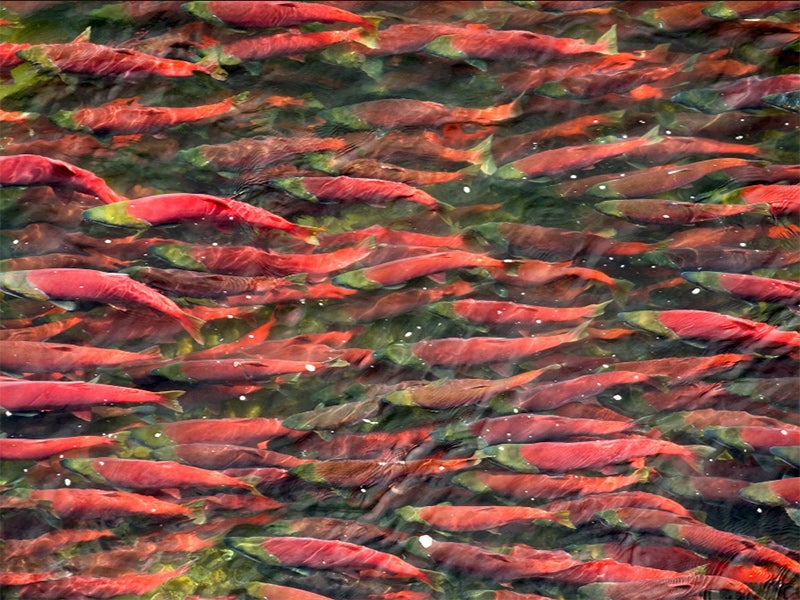Earthjustice stands with western Alaska tribes and families after severe storms devastated entire communities, displacing more than 1,000 residents just before winter. Learn more and how you can help.
Everything You Need To Know About The Pebble Mine
Earthjustice attorney Tom Waldo answers some basic questions and lays out the facts about Friday's big news on the Pebble mine in Alaska.

This page was published 11 years ago. Find the latest on Earthjustice’s work.
Earthjustice attorney Tom Waldo answers some basic questions and lays out the facts about Friday’s big news on the Pebble Mine in Alaska.
Q. What did the U.S. Environmental Protection Agency just do?
Last Friday, the EPA proposed to restrict development of the Pebble deposit in Alaska’s prized Bristol Bay watershed. This is the site of a controversial proposal for a gold and copper mine that, if approved, would become the largest and most destructive open-pit mine ever constructed in North America.
The area is also home to world-class salmon runs, Native tribes, and a $1 billion fishing industry.
In 2009 alone, data shows that the Bristol Bay’s natural resources provided over 14,000 full- and part-time jobs. That’s what’s at stake here.
EPA has authority to take this action under section 404(c) of the Clean Water Act if the agency determines that the discharges “will have an unacceptable adverse effect on … fishery areas (including spawning and breeding areas), … or recreational areas.”
EPA’s action on Friday was a proposed scientific determination under this provision.
Q. What is the Pebble Mine project?
It’s a project to build a gold and copper mine that would create a mine pit nearly as deep as the Grand Canyon. EPA estimates the mine would require excavation of the largest open pit ever constructed in North America and would cover nearly seven square miles at a maximum depth of over 3/4 of a mile. The maximum depth of the Grand Canyon is about one mile.
As proposed in its largest form, mine waste from the mine would fill a large football stadium up to 3,900 times. This includes mine tailings and waste rock.
Massive mine tailings impoundments would cover approximately 19 square miles and waste rock piles that would cover nearly nine square miles in an area with productive streams and wetlands.
This mining operation would cover an area larger than Manhattan. This includes all three mine components the EPA considered (mine pit, tailings impoundments, and waste rock piles).
Q. What kind of restrictions is the EPA proposing?
Put simply, the EPA’s proposal would prohibit any mine that would destroy more than five miles of salmon streams or more than 1,100 acres of wetlands or lakes, or that would reduce water flow through salmon streams exceeding specified thresholds. These restrictions would, in practice, prevent the development of the Pebble mine at even the smallest scenario that Pebble has proposed in its filings with the Securities and Exchange Commission.
The EPA’s proposal Friday is not final action. It is subject to public comment and public hearings. The proposal would not prohibit mining in the region, or even of the Pebble deposit, but it would prevent the type of mega-mine Pebble has proposed.
Q. What is the basis of the EPA’s proposal to restrict mining on the Pebble deposit?
EPA is recognizing that Alaska’s Bristol Bay watershed is an “area of unparalleled ecological value, boasting salmon diversity and productivity unrivaled anywhere in North America. As a result, the region is a globally significant resource with outstanding value.”
The EPA writes in its proposal on Friday:
“The Bristol Bay watershed’s streams, wetlands, and other aquatic resources support world-class, economically important commercial and sport fisheries for salmon and other fishes, as well as a more than 4,000-year-old subsistence-based way of life for Alaska Natives. Each year Bristol Bay supports the world’s largest runs of sockeye salmon, producing approximately half of the world’s sockeye salmon. These sockeye salmon represent the most abundant and diverse populations of this species remaining in the United States. … Bristol Bay is remarkable as one of the last places on Earth with such bountiful and sustainable harvests of wild salmon. One of the main factors leading to the success of this fishery is the fact that its aquatic habitats are untouched and pristine, unlike the waters that support many other fisheries.
“… The Bristol Bay commercial salmon fishery generates the largest component of this economic activity, with an estimated value of $300 million (sales from fishers to processors) and employment for over 11,000 full- and parttime workers (EPA 2014: Chapter 5).”
Q. What happens next?
The EPA needs to hear from as many people as possible that this was the right thing to do.
We need to thank EPA for taking this next important step to protect the incomparable resources of Bristol Bay. The EPA will be taking public comments on this proposed determination. We need to get our comments and gratitude into the public record, to bolster the EPA in holding fast to this determination and not backing down to mining industry pressure. EPA explains how to submit your comments: http://www2.epa.gov/bristolbay/public-involvement-bristol-bay-404c-process#comments.
Earthjustice is also consulting with scientific experts to ensure that the thresholds EPA proposes for stream and wetland loss are sufficient to protect salmon habitat.
Q. What is the mining company doing about this?
Suing the EPA! The Pebble Limited Partnership, joined by the State of Alaska, has filed a lawsuit in the U.S. District Court for Alaska to try to stop EPA’s public process midcourse and prevent the agency from exercising its responsibilities under section 404(c) of the Clean Water Act. The Earthjustice team in Alaska is evaluating this lawsuit carefully and reviewing options to defend EPA’s authority.
Opened in 1978, our Alaska regional office works to safeguard public lands, waters, and wildlife from destructive oil and gas drilling, mining, and logging, and to protect the region's marine and coastal ecosystems.